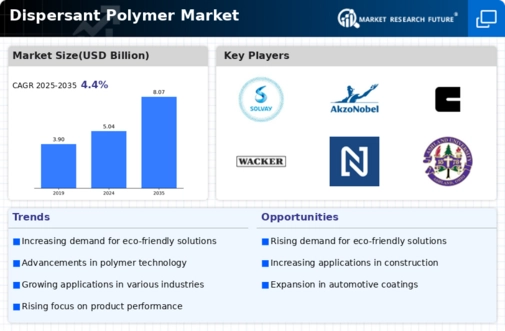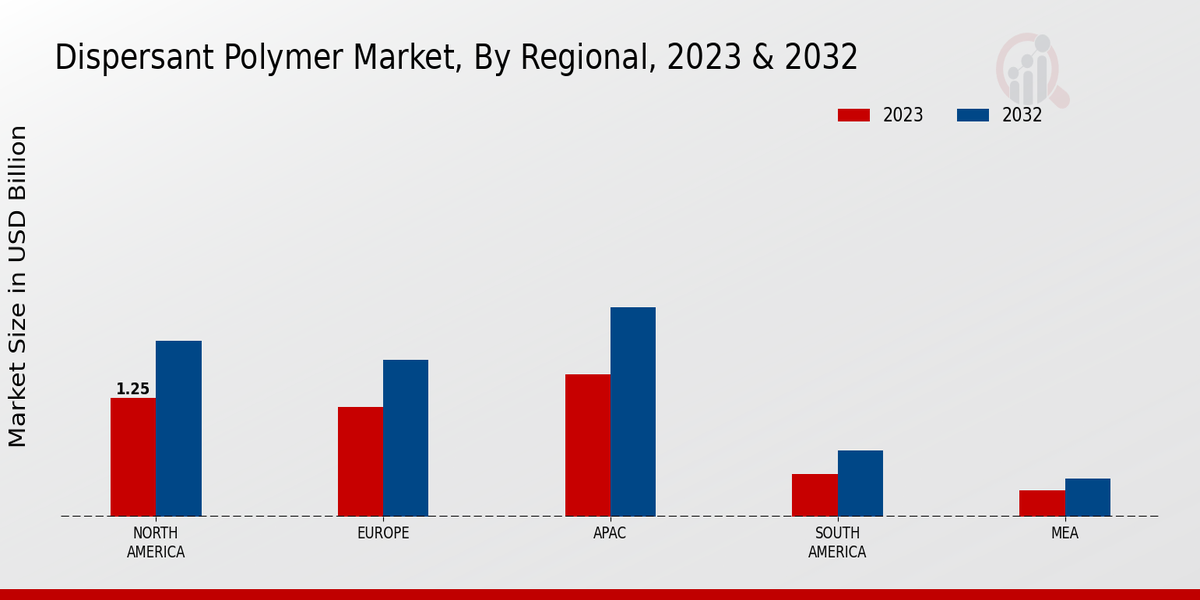Market Growth Projections
The Global Dispersant Polymer Market Industry is projected to experience substantial growth in the coming years. With a market value of 5.04 USD Billion in 2024, it is anticipated to reach 8.07 USD Billion by 2035, reflecting a compound annual growth rate of 4.37% from 2025 to 2035. This growth trajectory indicates a robust demand for dispersant polymers across various applications, driven by technological advancements and increasing regulatory support for sustainable practices. The market's expansion is likely to be influenced by ongoing investments in research and development, as well as the strategic expansion of manufacturing capabilities in emerging markets.
Technological Advancements
Technological advancements play a crucial role in the evolution of the Global Dispersant Polymer Market Industry. Innovations in polymer chemistry and formulation techniques lead to the development of more efficient and environmentally friendly dispersants. For example, the introduction of bio-based dispersant polymers is gaining traction, appealing to eco-conscious consumers and industries. These advancements not only improve performance but also align with sustainability goals. As a result, the market is likely to witness a compound annual growth rate of 4.37% from 2025 to 2035, indicating a robust future driven by continuous innovation.
Rising Demand in Various Industries
The Global Dispersant Polymer Market Industry experiences a notable increase in demand across multiple sectors, including paints and coatings, construction, and personal care. This trend is driven by the need for improved product performance and stability. For instance, the construction sector increasingly utilizes dispersant polymers to enhance the properties of cement and concrete mixtures. As a result, the market is projected to reach 5.04 USD Billion in 2024, reflecting the growing reliance on these materials for high-quality applications. This demand is expected to continue, as industries seek innovative solutions to meet consumer expectations.
Regulatory Support for Sustainable Practices
Regulatory frameworks promoting sustainable practices significantly influence the Global Dispersant Polymer Market Industry. Governments worldwide are implementing stringent regulations aimed at reducing environmental impact, which encourages the adoption of eco-friendly dispersant polymers. For instance, the European Union's REACH regulation emphasizes the need for safer chemical substances, prompting manufacturers to innovate and comply. This regulatory support not only drives market growth but also fosters a competitive landscape where companies prioritize sustainability. Consequently, the market is expected to grow, reaching 8.07 USD Billion by 2035 as industries adapt to these evolving standards.
Global Expansion of Manufacturing Capabilities
The Global Dispersant Polymer Market Industry is witnessing a strategic expansion of manufacturing capabilities across various regions. Companies are establishing production facilities in emerging markets to cater to the growing demand for dispersant polymers. This expansion not only enhances supply chain efficiency but also allows manufacturers to respond swiftly to regional market needs. For instance, the establishment of new plants in Asia-Pacific is indicative of the region's rising consumption of dispersant polymers in industries such as automotive and construction. This trend is expected to contribute to the overall market growth, reinforcing the industry's global presence.
Increased Investment in Research and Development
Investment in research and development is a pivotal driver for the Global Dispersant Polymer Market Industry. Companies are allocating substantial resources to explore new formulations and applications, aiming to enhance product performance and meet diverse consumer needs. This focus on R&D leads to the discovery of novel dispersant polymers that cater to specific industry requirements, such as improved dispersion stability and reduced viscosity. As a result, the market is poised for growth, with projections indicating a steady increase in value as innovations emerge. This commitment to R&D is likely to shape the future landscape of the industry.




















Leave a Comment